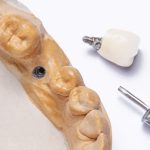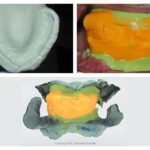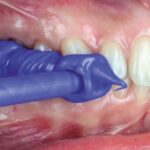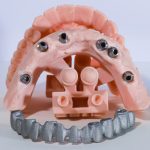25
Sep
The implant-prosthetic misfit: analogue and digital impression and other factors involved

According to the Glossary of Prosthodontics Terms (1), “fit” is defined as the “adaptation of any dental restoration to its site, in the mouth”.
In implantology and implant prosthetics, the correct adaptation of a prosthesis to dental implants is very important.
In this case the, passive fitting search turns out to be a fundamental step without which it is impossible to proceed with the final processing of implant prosthetic products (2).
In fact, this fitting at implant/prosthetic connection level needs to avoid generating stress or other situations that could cause biological or mechanical complications over the long term. (3).
In fact, a mismatch between the prosthesis and the implants, or the secondary abutments (in the case of a multi-unit abutment), generates stress and tension which, depending on the type of misfit, can be exerted on the prosthetic superstructures (framework, connection screws, coating materials), on the implants or on the peri-implant bone (4,5).
The misfit can be vertical, horizontal, angular or rotational, depending on the spatial axis in which unequal interactions between the implant/prosthetic coupling surfaces occur. (6,7).
The main factors that influence the fitting of an implant-prosthetic structure
Among the factors that influence the fitting of an implant-prosthetic structure we include the type of impression (8,9).
#1 The type of impression
The process, the technique, the impression materials or the scanners, with their different scanning strategies used to take the impression on implants, are the initial factors responsible for inaccuracies in producing the cast from which the prosthesis will then be made (see also our article “Impression on multiple implants: is it possible without splinting?”) (10).
Nowadays, digital technologies make it possible even to think of working without a cast in a fully digital workflow (11).
However, it is always the clinical case that determines whether a digital process can be fully trusted or not.
In single-implant situations or in cases where multiple implants are rehabilitated, but which are parallel to each other and in a hemi-arch, it is possible to carry out a full-digital protocol (8,9), whereas, for the complete arch, the analogue workflow with a rigid material impression and production of a plaster cast still seems to be the more reliable solution (8,9).
In the full-digital workflow, when working without any physical cast, any misfit issues that may exist in the frameworks cannot be verified before production of the prosthetic framework and cannot be corrected without taking another intraoral scan (11).
In cases where these types of difficulties can be identified, it is therefore always useful to produce at least one 3D printed cast, which can be used both to verify the impression made and as a working model even in the event that the prosthetic framework is modified (12).
Obviously, production of the 3D printed model entails discrepancies related to the printer setting parameters, type of resin, and so on (for further information on these issues, see the article “Plaster casts vs. 3D printable casts: characteristics and accuracy factors compared“), which can in turn influence the position of the implant analogues in the cast (13).
However, the possibility of building a verification jig and modifying the model by repositioning the analogues, as is usually done with plaster casts, is of considerable importance in complex cases in order to avoid misfit problems. (14)
#2 The manufacturing technology of prosthetic frameworks
Another very important factor is the manufacturing technology of the prosthetic frameworks (15,16).
Thanks to the advent of digital technology, there are new methods and new materials available nowadays, which are used to manufacture implant-prosthetic frameworks, such as milling or 3D printing.
Milled zirconium, for example, is a material that can be used nowadays for this purpose; in addition to its numerous aesthetic advantages, it may not require coating material, as was the case with metal (17,18).
However, zirconium always requires a Ti base at implant/prosthetic connection level; in fact, being a polycrystalline ceramic, it is not a material suitable for threading, which would inevitably lead to microfractures.
Furthermore, a prosthetic screw produced from titanium or other metals compatible with the internal threads of the implants or MUAs would present problems in terms of adaptation and mechanical stability with the zirconium structure, given the materials’ different resistance and ductility properties (19).
The advantage of Ti bases, then, is to reduce any tension in the prosthetic structure resulting from manufacturing inaccuracies, thanks to the small gap necessary for cementation with the framework (20).
#3 Other factors implicated in misfit
However, there are also other factors implicated in misfit, such as:
- The framework design (21);
- The application of coating material (22);
- The type of implant/prosthetic connection (23);
and others that we can mention but which require further study.
Conclusions
The correct fit of a prosthesis on dental implants is crucial to ensure the longevity and clinical success of implant rehabilitations.
The search for passive fitting is an essential step to avoid long-term biological and mechanical complications.
The choice of materials, manufacturing technologies and workflow always requires specific considerations for each clinical case aimed at maximising outcomes.
References:
- The Glossary of Prosthodontic Terms. The Journal of Prosthetic Dentistry. 2017 May;117(5):C1-e105.
- Lops, D., Bruna, E., & Fabianelli, A. (2014). La protesi implantare. Dental Cadmos, 6(82), 386.
- Goodacre CJ, Bernal G, Rungcharassaeng K, Kan JYK. Clinical complications with implants and implant prostheses. J Prosthet Dent. 2003 Aug;90(2):121–32.
- Nogueira MCF, Bacchi A, Mesquita MF, Santos MBF, Consani RLX. Influence of Cross-Section Design and Vertical Misfit on Stress Distribution in Overdenture Retaining System: 3-Dimensional Finite Element Analysis. Implant Dent. 2018 Aug;27(4):445–51.
- Winter W, Mohrle S, Holst S, Karl M. Bone loading caused by different types of misfits of implant-supported fixed dental prostheses: a three-dimensional finite element analysis based on experimental results. Int J Oral Maxillofac Implants. 2010;25(5):947–52.
- Prisco R, Troiano G, Laino L, Zhurakivska K. Rotational tolerances of a titanium abutment in the as-received condition and after screw tightening in a conical implant connection. J Adv Prosthodont. 2021 Dec;13(6):343–50.
- Abduo J, Judge R. Implications of Implant Framework Misfit: An Animal Study on an Ovine Model. J Oral Implantol. 2021 Jun 1;47(3):183–9.
- Ahlholm P, Sipilä K, Vallittu P, Jakonen M, Kotiranta U. Digital Versus Conventional Impressions in Fixed Prosthodontics: A Review. J Prosthodont. 2018 Jan;27(1):35–41.
- Chochlidakis KM, Papaspyridakos P, Geminiani A, Chen CJ, Feng IJ, Ercoli C. Digital versus conventional impressions for fixed prosthodontics: A systematic review and meta-analysis. J Prosthet Dent. 2016 Aug;116(2):184-190.e12.
- Shillinburg HT, et al. Fundamentals of fixed prosthodontics. Quintessence Publishing Company, 1997.
- Alghazzawi TF. Advancements in CAD/CAM technology: Options for practical implementation. Journal of Prosthodontic Research. 2016 Apr;60(2):72–84.
- Maria R, Tan MY, Wong KM, Lee BCH, Chia VAP, Tan KBC. Accuracy of Implant Analogs in 3D Printed Resin Models. J Prosthodont. 2021 Jan;30(1):57–64.
- Revilla-León M, Gonzalez-Martín Ó, Pérez López J, Sánchez-Rubio JL, Özcan M. Position Accuracy of Implant Analogs on 3D Printed Polymer versus Conventional Dental Stone Casts Measured Using a Coordinate Measuring Machine. J Prosthodont. 2018 Jul;27(6):560–7.
- Arias SR, Londono J, Hemati A. A method for fabrication of extraoral verification template for implant master cast. The Journal of Prosthetic Dentistry. 2022 Jun 1;127(6):943–4.
- Abduo J. Fit of CAD/CAM implant frameworks: a comprehensive review. J Oral Implantol. 2014 Dec;40(6):758–66.
- Bhering CLB, Mesquita MF, Kemmoku DT, Noritomi PY, Consani RLX, Barão VAR. Comparison between all-on-four and all-on-six treatment concepts and framework material on stress distribution in atrophic maxilla: A prototyping guided 3D-FEA study. Materials Science and Engineering: C. 2016 Dec;69:715–25.
- Alikhasi M, Monzavi A, Bassir SH, Naini RB, Khosronedjad N, Keshavarz S. A comparison of precision of fit, rotational freedom, and torque loss with copy-milled zirconia and prefabricated titanium abutments. Int J Oral Maxillofac Implants. 2013 Aug;28(4):996–1002.
- Stimmelmayr M, Edelhoff D, Güth JF, Erdelt K, Happe A, Beuer F. Wear at the titanium-titanium and the titanium-zirconia implant-abutment interface: a comparative in vitro study. Dent Mater. 2012 Dec;28(12):1215–20.
- Anusavice KJ, Shen C, Rawls HR. Phillips’ science of dental materials. 12th edition. Elsevier Health Sciences; 2012. 492–494 p.
- Spazzin AO, Camargo B, Bacchi A. Ensuring passivity and retrievability for immediate complete-arch implant-supported prostheses. The Journal of Prosthetic Dentistry. 2017 Feb;117(2):214–7.
- Drago C, Howell K. Concepts for designing and fabricating metal implant frameworks for hybrid implant prostheses. J Prosthodont. 2012 Jul;21(5):413–24.
- Revilla-León M, Sánchez-Rubio JL, Pérez-López J, Rubenstein J, Özcan M. Discrepancy at the implant abutment-prosthesis interface of complete-arch cobalt-chromium implant frameworks fabricated by additive and subtractive technologies before and after ceramic veneering. J Prosthet Dent. 2021 May;125(5):795–803.
- Bédouin Y, Lefrançois E, Salomon JP, Auroy P. Abutment rotational freedom on five implant systems with different internal connections. J Prosthet Dent. 2023 Mar;129(3):433–9.
Would you like more information about Zhermack Dental products and solutions?
Contact us




 Zhermack SpA has been one of the most important producers and international distributors of alginates, gypsums and silicone compounds for the dental sector for over 40 years. It has also developed solutions for the industrial and wellbeing sectors.
Zhermack SpA - Via Bovazecchino, 100 - 45021 Badia Polesine (RO), Italy.
Zhermack SpA has been one of the most important producers and international distributors of alginates, gypsums and silicone compounds for the dental sector for over 40 years. It has also developed solutions for the industrial and wellbeing sectors.
Zhermack SpA - Via Bovazecchino, 100 - 45021 Badia Polesine (RO), Italy.


